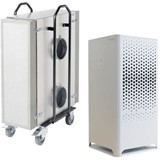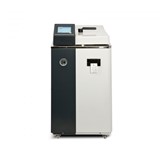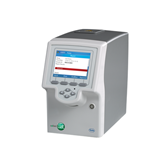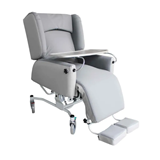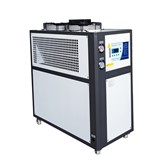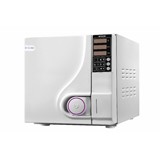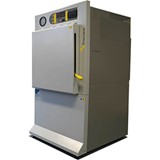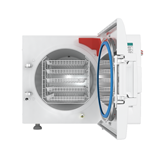Autoclaves are versatile devices that have become essential in a wide range of industries, playing a pivotal role in the sterilization of instruments, equipment, and materials. With their ability to eliminate harmful microorganisms, autoclaves ensure the safety, hygiene, and quality of various products and procedures. This comprehensive guide explores the extensive uses and applications of autoclaves, highlighting their significance in specific industries and providing insights into their operational principles and features.
By understanding the different types of autoclaves available, their features, and their applications across various industries, professionals can make informed decisions when choosing the most suitable autoclave for their specific needs. This comprehensive guide aims to provide the necessary information and insights to assist professionals in selecting the right autoclave, ensuring efficient sterilization, and promoting the well-being of individuals and the integrity of their work across diverse fields;
Understanding Dental Autoclave Cycle Settings and Parameters
Dental autoclaves are sophisticated devices that offer various cycle settings and parameters to achieve effective sterilization of instruments and equipment. It is essential to have a clear understanding of these settings to ensure proper use and optimal sterilization results. In this section, we will explore the key cycle settings and parameters commonly found in dental autoclaves.
- Sterilization Temperature: The sterilization temperature is a critical parameter that determines the effectiveness of the sterilization process. Most dental autoclaves operate at temperatures between 121°C (250°F) and 134°C (273°F). Higher temperatures are generally more effective in killing microorganisms, including bacteria, viruses, and spores. The specific temperature required may vary depending on the items being sterilized and the manufacturer's recommendations.
- Sterilization Time: The sterilization time refers to the duration for which the autoclave maintains the specified sterilization temperature. It is crucial to ensure that the items being sterilized remain at the required temperature for the recommended duration to achieve thorough sterilization. The sterilization time can range from a few minutes to several minutes, depending on the autoclave model and the type of instruments or materials being sterilized.
- Drying Time: After the sterilization process is complete, some dental autoclaves offer a drying cycle to remove excess moisture from the sterilized items. This is particularly beneficial for preventing moisture-related damage and ensuring the usability of instruments. The drying time can vary, and some autoclaves may allow users to adjust the drying duration based on their specific requirements.
- Pre-vacuum and Post-vacuum Phases: Certain dental autoclaves incorporate pre-vacuum and post-vacuum phases in their cycle settings. These phases involve creating a vacuum inside the autoclave chamber before sterilization and after the sterilization process is complete, respectively. Pre-vacuum helps to remove air and enhance steam penetration, while post-vacuum aids in drying the sterilized items. These phases contribute to improved sterilization efficacy and overall instrument drying.
- Load Type Selection: Dental autoclaves may offer different load type selections to accommodate various types of instruments and materials. Common load type options include solid, wrapped, or hollow instruments. Selecting the appropriate load type ensures that the autoclave adjusts the cycle parameters accordingly, taking into account factors such as steam penetration and drying needs specific to the load type.
- Cycle Customization: Some dental autoclaves allow users to customize cycle settings based on their specific requirements. This may include adjusting parameters such as sterilization time, drying time, or temperature. Customization options provide flexibility and allow users to tailor the cycle settings to different instrument types or specific sterilization needs.
- Monitoring and Indicators: Dental autoclaves often feature monitoring systems and indicators to ensure the proper execution of the sterilization cycle. These may include digital displays that show real-time information such as temperature and pressure inside the autoclave chamber. Additionally, indicators or alarms may alert users if there are any deviations or abnormalities during the sterilization process.
It is important to note that the specific cycle settings and parameters can vary among different dental autoclave models. Therefore, it is crucial to refer to the manufacturer's instructions and guidelines for the specific autoclave being used. Understanding the cycle settings and parameters, along with following the recommended guidelines, will help ensure proper sterilization and maintain the highest level of infection control in dental practices.
Sterilization Cycles and Their Purpose
Dental autoclaves offer different sterilization cycles, each designed to fulfill specific purposes and achieve effective sterilization of instruments and equipment. Understanding these sterilization cycles and their purpose is essential for proper use and optimal sterilization outcomes. In this section, we will explore the common sterilization cycles found in dental autoclaves and their respective purposes.
- Pre-vacuum Cycle: The pre-vacuum cycle is characterized by creating a vacuum inside the autoclave chamber before the sterilization process begins. The purpose of this cycle is to remove air and facilitate effective steam penetration into the load. By eliminating air, the pre-vacuum cycle enhances the sterilization process, ensuring thorough penetration of steam into all areas of the instruments and materials being sterilized. This cycle is particularly useful for sterilizing hollow instruments, such as handpieces and syringes, which require efficient air removal to achieve effective sterilization.
- Gravity Cycle: The gravity cycle relies on the natural force of gravity to remove air from the autoclave chamber and replace it with steam. This cycle is commonly used for general-purpose sterilization in dental practices. Instruments, materials, and small equipment that can withstand the longer cycle times associated with the gravity cycle are typically processed using this method. The gravity cycle is effective in achieving sterilization, although it may require slightly longer cycle times compared to other cycles.
- Flash Cycle: The flash cycle, also known as the rapid cycle or quick cycle, is designed for fast sterilization of unwrapped, solid instruments. This cycle is intended for urgent sterilization needs, where quick turnaround times are required. The flash cycle achieves rapid sterilization by utilizing higher temperatures and shorter exposure times. However, it is important to note that not all instruments or materials may be suitable for processing in the flash cycle, and manufacturers' guidelines should be followed to ensure proper sterilization.
- Wrapped Cycle: The wrapped cycle is specifically designed for sterilizing instruments and materials that are wrapped in sterilization pouches or packs. Wrapping instruments provides an additional barrier of protection and helps maintain sterility during storage. The wrapped cycle ensures effective sterilization by allowing steam to penetrate the wrapped materials while maintaining sterility during the drying phase. This cycle is commonly used for preserving the sterility of instruments until they are ready for use.
- Gentle Cycle: The gentle cycle, also known as the delicate cycle, is designed for sterilizing delicate or heat-sensitive instruments and materials. It employs lower temperatures and gentler conditions to prevent damage to sensitive items while still achieving effective sterilization. The gentle cycle is ideal for items such as plastic items, certain handpieces, and other heat-sensitive materials that require more careful handling during the sterilization process.
- Customizable Cycles: Some dental autoclaves offer customizable cycles, allowing users to adjust sterilization parameters based on their specific needs. These parameters may include temperature, time, and drying settings. Customizable cycles provide flexibility to tailor the sterilization process to different instruments, load sizes, and specific sterilization requirements.
It is important to consult the manufacturer's instructions and guidelines for the specific dental autoclave being used to understand the available sterilization cycles and their recommended applications. Following the manufacturer's recommendations ensures that the sterilization cycles are utilized appropriately, leading to effective sterilization and maintaining the highest level of infection control in dental practices.
6 Key Parameters in Dental Autoclave Sterilization
Dental autoclave sterilization involves several key parameters that must be carefully controlled to ensure effective and reliable sterilization of instruments and equipment. These parameters play a critical role in achieving the desired level of microbial inactivation while maintaining the integrity of the items being sterilized. In this section, we will explore the key parameters involved in dental autoclave sterilization.
- Temperature: Temperature is a crucial parameter in autoclave sterilization. The autoclave chamber must reach and maintain a specific temperature for a specified period to ensure effective sterilization. The recommended temperature for dental autoclave sterilization is typically around 121 to 134 degrees Celsius (250 to 273 degrees Fahrenheit). The high temperature helps inactivate microorganisms, including bacteria, viruses, and spores, ensuring the sterility of the instruments and equipment.
- Pressure: Pressure is another important parameter in dental autoclave sterilization. The autoclave creates a high-pressure environment by introducing steam into the chamber. The pressure within the autoclave chamber assists in achieving the desired temperature and aids in the penetration of steam into the instruments and materials being sterilized. The recommended pressure for dental autoclave sterilization is typically around 15 to 30 pounds per square inch (psi).
- Time: The sterilization time, also known as the exposure or holding time, refers to the duration for which the instruments and materials are exposed to the specified temperature and pressure within the autoclave. The recommended sterilization time varies depending on the specific sterilization cycle being used, but it generally ranges from 15 to 30 minutes. Sufficient exposure time is necessary to ensure that all microorganisms are effectively killed and the sterilization process is thorough.
- Drying Time: After the sterilization process is complete, a drying phase follows to remove excess moisture from the instruments and materials. Drying helps prevent the growth of microorganisms during storage and maintains the integrity of the sterilized items. The drying time can vary depending on the specific autoclave model and cycle settings. It is important to follow the manufacturer's guidelines regarding the recommended drying time to ensure optimal results.
- Load Size and Configuration: The size and configuration of the load being sterilized can impact the sterilization process. It is essential to properly arrange the instruments and materials inside the autoclave chamber, allowing for adequate steam penetration and circulation. Overloading the chamber or improper arrangement may hinder the effectiveness of sterilization. It is recommended to follow the manufacturer's instructions regarding load size and configuration to ensure proper sterilization.
- Water Quality: The quality of water used in dental autoclaves can also affect the sterilization process. High-quality, distilled or deionized water is typically recommended to minimize the risk of mineral deposits and ensure the proper functioning of the autoclave. Using poor-quality water may lead to scaling, clogging, or reduced performance of the autoclave system.
These key parameters should be carefully monitored and controlled during dental autoclave sterilization to ensure consistent and reliable results. Regular maintenance and calibration of the autoclave are essential to ensure accurate temperature and pressure control. Additionally, it is important to follow the manufacturer's instructions and guidelines for load configuration, sterilization times, and recommended water quality to achieve optimal sterilization outcomes.
Validating Dental Autoclave Performance
Validating the performance of a dental autoclave is a crucial step in ensuring its effectiveness in sterilizing instruments and equipment. Validation involves verifying that the autoclave consistently achieves the desired sterilization parameters and produces reliable and reproducible results. By conducting regular performance validation, dental professionals can maintain a high standard of infection control and ensure the safety of patients and staff. In this section, we will discuss the process of validating dental autoclave performance.
- Biological Indicators (BIs): Biological indicators are essential tools for validating autoclave performance. BIs contain a known population of highly resistant bacterial spores, such as Geobacillus stearothermophilus, that are exposed to the sterilization process. After the sterilization cycle, the BIs are incubated and checked for spore growth. If no growth is observed, it indicates that the autoclave effectively sterilized the load. BIs provide a direct assessment of the autoclave's ability to achieve microbial inactivation and are considered the gold standard for validation.
- Chemical Indicators (CIs): Chemical indicators are used in conjunction with biological indicators to monitor the performance of the autoclave. CIs are typically placed on the outside of instrument packs or in specific locations within the load. They undergo a color change or other chemical reaction when exposed to specific temperature and pressure conditions. CIs provide a visual indication that the load has been exposed to the sterilization process. However, they do not provide direct information about microbial inactivation and should not be used as the sole means of validation.
- Cycle Monitoring: Regular monitoring of the autoclave cycles is essential for validation. This includes recording and reviewing temperature, pressure, and cycle duration data for each sterilization cycle. Monitoring ensures that the autoclave consistently reaches and maintains the required parameters throughout the cycle. Any deviations or inconsistencies should be investigated and addressed promptly to maintain the integrity of the sterilization process.
- Maintenance and Calibration: Proper maintenance and calibration of the autoclave are crucial for validation. Regular maintenance, including cleaning and inspection, helps ensure that the autoclave is functioning properly and that all components are in good working condition. Calibration involves verifying the accuracy of temperature and pressure sensors and adjusting them if necessary. Routine maintenance and calibration activities should be performed by qualified personnel according to the manufacturer's guidelines.
- Documentation: Comprehensive documentation is a vital part of the validation process. All validation activities, including biological and chemical indicator results, cycle monitoring data, maintenance records, and calibration reports, should be thoroughly documented. Documentation provides a record of the autoclave's performance over time and serves as evidence of compliance with regulatory requirements. It also aids in identifying trends, troubleshooting issues, and demonstrating adherence to best practices.
- Training and Education: Ensuring that dental professionals and staff are properly trained in autoclave operation and validation procedures is essential. Training should cover proper loading techniques, cycle selection, monitoring procedures, and interpretation of validation results. By educating the personnel responsible for autoclave operation, the risk of errors or non-compliance can be minimized, and the effectiveness of validation efforts can be enhanced.
Safely Loading and Unloading Your Dental Autoclave
Proper loading and unloading of dental autoclaves is crucial to ensure the effective sterilization of instruments and equipment while maintaining the safety of dental professionals. Following the correct procedures minimizes the risk of cross-contamination, prevents damage to instruments, and promotes efficient sterilization. In this section, we will provide a step-by-step guide on safely loading and unloading your dental autoclave.
Loading Procedure:
- Prepare the Instruments: Before loading, ensure that all instruments and equipment to be sterilized are clean and free from debris. Remove any residual materials or contaminants by thoroughly rinsing or using appropriate cleaning methods.
- Arrange Instruments Properly: Place the instruments in the autoclave chamber, ensuring they are spaced adequately and not overcrowded. Allow sufficient room for steam circulation and heat penetration to ensure thorough sterilization. Avoid stacking or overlapping instruments as it may hinder effective sterilization.
- Use Sterilization Pouches or Wraps: Enclose individual instruments or instrument sets in sterilization pouches or wraps designed for dental autoclaves. Ensure that the pouches are properly sealed to prevent the entry of contaminants during sterilization. Follow the manufacturer's instructions for using the sterilization packaging material.
- Positioning the Pouches: Arrange the sterilization pouches in a way that allows proper steam circulation around each pouch. Avoid blocking the steam vents or obstructing the autoclave chamber walls. Ensure that the pouches do not touch each other, as this can hinder effective heat transfer.
- Loading Trays and Cassettes: If using trays or cassettes to organize instruments, make sure they are compatible with your autoclave and designed for dental instrument sterilization. Place the instruments in the trays or cassettes according to the manufacturer's instructions, ensuring proper spacing and arrangement for effective sterilization.
- Closing the Autoclave Chamber: Once all instruments are loaded, close the autoclave chamber securely. Follow the manufacturer's instructions for proper sealing or locking mechanisms. Ensure that the door gasket or seal is intact and free from any damage or debris.
Unloading Procedure:
- Ensure Proper Cooling: After the sterilization cycle is complete, allow the autoclave to cool down before opening the chamber. Refer to the manufacturer's instructions for the recommended cooling time. Opening the chamber too soon can compromise the sterilization process and increase the risk of burns.
- Wear Personal Protective Equipment (PPE): Before unloading, put on appropriate PPE, including heat-resistant gloves and protective eyewear, to protect yourself from potential heat and steam exposure.
- Open the Autoclave Chamber Carefully: Once the autoclave has cooled down, open the chamber door slowly and cautiously. Be mindful of any residual steam that may escape when opening the door. Avoid placing your face or hands directly in front of the door opening.
- Allow Instruments to Cool: After opening the chamber, allow the instruments to cool inside the autoclave before handling them. This helps prevent burns and ensures the instruments are safe to touch.
- Check Sterilization Indicators: Examine the sterilization indicators on the instrument pouches or wraps to ensure they have changed color or reached the appropriate indicator mark, indicating successful sterilization. Do not use any pouch or wrap that does not show proper sterilization indicators.
- Remove and Store Sterilized Instruments: Carefully remove the sterilized instrument pouches or wraps from the autoclave chamber using heat-resistant gloves. Place the sterilized instruments in a designated, clean, and dry area for storage. Follow proper handling and storage procedures to maintain the sterility of the instruments until their use.
5 Types of Autoclave Cycles and Their Applications
Dental autoclaves offer various sterilization cycles that are tailored to different dental instruments and materials, ensuring effective disinfection and sterilization. Each cycle is designed to accommodate specific requirements and optimize the sterilization process. Let's explore some of the common types of dental autoclave cycles and their applications:
-
Unwrapped Cycle:
The unwrapped cycle, also known as the "flash" cycle, is designed for the rapid sterilization of unwrapped or single-use instruments. It operates at higher temperatures and shorter exposure times, typically ranging from 3 to 7 minutes. This cycle is ideal for urgent instrument sterilization when time is of the essence.
-
Wrapped Cycle:
The wrapped cycle is specifically designed for the sterilization of wrapped instruments, including those placed in sterilization pouches or wraps. It involves a longer sterilization cycle to ensure the effective penetration of steam through the packaging material and complete sterilization of the enclosed instruments. The exposure time may vary depending on the size and contents of the wrapped package.
-
Hollow Load Cycle:
The hollow load cycle is designed to sterilize instruments with hollow lumens or channels, such as dental handpieces or syringes. These instruments require special attention to ensure that steam penetrates and sterilizes the entire length of the hollow spaces. The hollow load cycle uses longer exposure times and precise temperature and pressure settings to achieve thorough sterilization.
-
Prion Cycle:
Prions are highly resilient infectious agents that can cause serious diseases. The prion cycle is specifically designed to inactivate prions effectively. It employs higher temperatures and longer exposure times to ensure the destruction of these resistant pathogens.
-
Bowie-Dick Test Cycle:
The Bowie-Dick test cycle is not a sterilization cycle but rather a daily test to assess the effectiveness of air removal from the autoclave chamber. It involves a specific test pack, known as the Bowie-Dick test pack, which contains a chemical indicator. The cycle is performed to check for the presence of air pockets or inadequate steam penetration, ensuring the proper functioning of the autoclave.
-
Customizable Cycles:
Some dental autoclaves offer customizable cycles that allow users to adjust the sterilization parameters based on specific requirements. These cycles provide flexibility to accommodate unique instruments, materials, or specialized sterilization needs. Users can set the desired temperature, pressure, and exposure time to achieve optimal sterilization results.
It's important to select the appropriate cycle based on the instruments, materials, and packaging used in dental practices. Following manufacturer guidelines and considering the specific requirements of the items being sterilized will ensure effective sterilization and compliance with infection control protocols.
In conclusion, dental autoclaves are indispensable devices in the field of sterilization, providing a reliable and effective means of eliminating harmful microorganisms. By following the proper operation, maintenance, and safety protocols, dental professionals can ensure the successful sterilization of instruments and equipment, thereby safeguarding the health and well-being of patients. Additionally, understanding the different cycle settings and parameters, as well as the purpose of sterilization cycles, allows for optimal use of dental autoclaves. By adhering to recommended guidelines and regularly validating autoclave performance, dental practices can maintain a high standard of infection control and ensure the safety and quality of their procedures.





